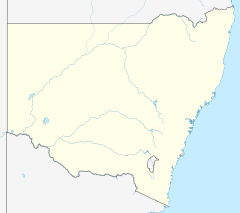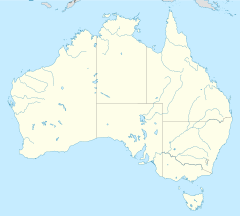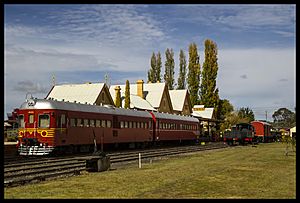Tenterfield railway station facts for kids
Quick facts for kids
Tenterfield
|
|||||||||||
|---|---|---|---|---|---|---|---|---|---|---|---|

Tenterfield railway station, 2017
|
|||||||||||
| Location | Railway Avenue, Tenterfield, Tenterfield Shire, New South Wales Australia |
||||||||||
| Coordinates | 29°03′20″S 152°00′19″E / 29.0555°S 152.0053°E | ||||||||||
| Owned by | Transport Asset Holding Entity | ||||||||||
| Operated by | State Rail Authority | ||||||||||
| Line(s) | Main Northern | ||||||||||
| Distance | 773.87 km (480.86 mi) from Central | ||||||||||
| Platforms | 1 | ||||||||||
| Tracks | 3 | ||||||||||
| Construction | |||||||||||
| Structure type | Ground | ||||||||||
| Architect |
|
||||||||||
| Other information | |||||||||||
| Status | Closed | ||||||||||
| Station code | TEN | ||||||||||
| History | |||||||||||
| Opened | 1 September 1886 | ||||||||||
| Closed | 22 October 1989 | ||||||||||
| Services | |||||||||||
|
|||||||||||
| Official name | Tenterfield Railway Station group | ||||||||||
| Type | State heritage (complex / group) | ||||||||||
| Designated | 2 April 1999 | ||||||||||
| Reference no. | 1267 | ||||||||||
| Type | Railway Platform / Station | ||||||||||
| Category | Transport - Rail | ||||||||||
| Location | |||||||||||
The Tenterfield railway station is a heritage-listed closed railway station and now railway museum. It is located on the Main Northern line in Tenterfield. This station served the town of Tenterfield. It first opened on 1 September 1886. At that time, the railway line was extended from Glen Innes.
Tenterfield was the end of the line until it reached Wallangarra on 16 January 1888. William Murray designed the station. He worked under John Whitton, who was the Chief Engineer for New South Wales Government Railways. The station was built in 1886. It is also known as the Tenterfield Railway Station group. This property was added to the New South Wales State Heritage Register on 2 April 1999. The station has one platform and two extra tracks for trains.
The last train to go north of Tenterfield was on 15 January 1988. It was a special trip for the Australian Railway Historical Society. The last train to go north of Glen Innes was on 22 October 1989. After this, the line officially closed north of Dumaresq. The last regular train service to Tenterfield was the Northern Mail. This service stopped in November 1988. The Northern Tablelands Express also served Tenterfield. It stopped running to Tenterfield in October 1985, ending its journey at Armidale.
After the station closed, it became the Tenterfield Railway Station Museum.
Contents
History of Tenterfield Station
The Tenterfield railway area is on the Main North line. This line runs from Sydney up to the Queensland border at Wallangarra. The Main North Line is also called the Great Northern Railway. It goes through the Central Coast, Hunter, and New England areas. This line was the main way to travel between Sydney and Brisbane. However, trains had to change tracks at Wallangarra because the track width was different. The line is now closed north of Armidale. The main route between Brisbane and Sydney is now the North Coast line.
Early Days of Tenterfield
In 1841, Sir Stuart Donaldson had a large sheep farm. He named it Tenterfield Station. Donaldson was the first Premier of New South Wales. He visited Tenterfield twice a year to check on his huge farm. The town of Tenterfield officially started in 1851. Land was sold there in 1854.
Gold was found nearby in 1858. This led to more people moving to the area. A bank opened in 1859, and a church was built in 1860. In the 1860s, a local newspaper started. A court, a hospital, and a public school also opened. By 1870, the town had five hotels and three churches. The Tenterfield Post Office was built in 1881.
Building the Railway Station
In February 1886, William Murray was chosen to build the Tenterfield station. He also built a goods shed, an engine shed, and a place for coal. He built a large turntable for turning trains around. On 1 September 1886, the railway line to Tenterfield officially opened. By 1891, the living quarters for engine drivers were finished. These were the last of the railway buildings on the site.
The railway area used to have a place for locomotives. This included an engine shed and living areas for staff. It also had a coal stage and a turntable. Some of these buildings are still there today. The original engine shed was built in 1886. A new one replaced it in 1908.
Changes Over Time
The railway facilities at Tenterfield stayed mostly the same for about 100 years. The platform was made longer in 1907. In 1960, the station master's house and the station got modern plumbing. However, some decorative parts of the buildings were removed to make them look more modern. By 1965, the station had lost some of its fancy iron and timber decorations.
By the 1960s, the Tenterfield locomotive depot was not needed as much. Steam trains were being replaced by diesel trains. Diesel trains did not need as many service buildings like ash pits or coal stages. On 8 June 1968, the locomotive shed at Tenterfield was taken down. This happened when steam trains stopped running on the Northern Line.
The development of the North Coast line meant fewer people used the Tenterfield line. People preferred the more direct route to Brisbane. The last mail and passenger train left Tenterfield in November 1988. On 17 July 1989, the State Rail Authority announced the station would close. It officially closed on 30 November 1990.
In 1991, the Tenterfield Railway Preservation Society was formed. They opened a Heritage Museum at the site in 1992. Today, the Office of Rail Heritage helps manage the site.
Important Historical Events
Tenterfield railway station is linked to several important events in Australia's history:
- 1889 – Sir Henry Parkes gave his famous Tenterfield speech. He called for the different Australian colonies to join together as one nation. This speech at the Tenterfield School of Arts was a big step towards Federation of Australia. He then left on a special train to Sydney.
- 1919 – A special quarantine area was set up at Tenterfield. This was during the influenza (flu) pandemic after World War I.
- 1942 – During World War II, Tenterfield was a secret military location. Thousands of soldiers were stationed in camps there. This was in case Japan invaded Australia. Small changes were made to the railway barracks for defence needs.
What You Can See at the Station
The station area has several important buildings and structures:
- A large station building from 1886.
- A platform, also from around 1886.
- A brick building for train staff from 1890.
- A weatherboard building for staff from around 1948.
- A goods shed for storing items.
- A shed for railway maintenance tools.
- A sign-on shed where staff would start their shifts.
Other items include a 18-metre (60 ft) turntable from 1899. This was used to turn locomotives around. There is also a loading platform and a jib crane from 1886. You can still see some parts of the old coal stage from around 1949.
The Station Building
The Tenterfield station building was finished in 1886. It is a long, narrow, single-story building made of brick. It has a painted outside. The building has a main central part with smaller sections on each side. It looks old-fashioned with steep, pointed roofs called gables. These gables have fancy wooden decorations. The building also has cast iron decorations and columns on its verandas.
The main part of the building has two sections that stick out. These have sharply pitched gables that rise above the roof. Three verandas run between these sections and on either side. The roof has many chimneys. The gables have decorative timber fretwork and vents. The front of the building has decorative details in the plaster. The back of the building looks similar. It has many doors and windows that open onto the platform. A deep veranda runs along the platform side. It is supported by cast iron columns. Inside, there is a waiting room in the middle. Other rooms are on either side, all with access from the platform.
The smaller side buildings have a gabled front. They have a lean-to shed or veranda opening onto a courtyard. The building on the south side is the men's toilet block. These buildings still look much like they did when they were built in 1886.
The Platform
The platform was built around 1886 and was made longer in 1907. It is covered with brick. The platform has two old timber gates, one at each end. It also has two metal signs that say "Tenterfield." You can also see an old Avery weighing scale.
Barracks Buildings
The brick barrack building was finished in 1890. This was where engine drivers used to live. It has a gabled roof with smaller gables facing the front and back. There are verandas with simple wooden posts on both sides. It has a chimney and decorative wooden trim. The building still has its original layout. It had four bedrooms, a combined toilet/washroom, a meal room, and a kitchen.
The weatherboard barracks were built around 1948. These are three single-story wooden huts. Each hut has wooden walls and floors. They have a window on the east side and a door on the west side. The roofs are unusual, with two layers of corrugated iron. This might mean the huts were built somewhere else and then moved here.
Goods Shed and Other Structures
The goods shed was built in 1886. It is 41.1 by 9.1 metres (135 ft × 30 ft) and covered with corrugated iron. It has a gabled roof supported by timber brackets. There is a small wooden office attached to the north side of the shed. The building is raised on brick supports. This made it easy to load and unload goods from train wagons.
The shed for railway maintenance tools has a steel frame and a gabled roof. It is used to display old railway trikes.
The sign-on shed was built in the 1940s. It was a small wooden office building. It had an office, a sign-on room, and a toilet/wash area. The building has a hipped roof and a unique corner brick fireplace. A veranda runs along the front. This building was restored in 1999 and is now used as an office.
The 1899 turntable is made of cast iron and is 18 metres (60 ft) wide. It is operated by hand. The loading platform is a raised concrete area with ramps. The T433 jib crane was built in 1886 and still works. Only small parts of the old coal stage from 1949 remain.
Condition and Changes
The Tenterfield railway area is in very good condition. Most of the original railway buildings are still there. The station buildings are in good shape.
Over the years, the station has had some changes:
- 1890 – Engine drivers' barracks were built.
- 1899 – The original 15-metre (50 ft) turntable was replaced with a larger 18-metre (60 ft) one.
- 1908 – The original engine shed was rebuilt and made larger.
- 1942 – Changes were made to the barracks for World War II defence needs.
- 1968 – The engine shed was taken down.
- 1989 – Train tracks were removed from the Tenterfield depot.
- 2000 – Restoration work was completed on the station and yard.
Why Tenterfield Station is Important
Tenterfield is a very important Victorian-era station complex. It was one of the last designed by John Whitton. It still has its original look, with a nice front garden and good support buildings. These include the old staff residence, barracks, and goods shed. The building still has many of its original features. It is one of the best-preserved station complexes in New South Wales.
The station building is a major structure in the northern part of the state. It shows how railways were first built in this area. The buildings are an important part of the town's look and add to its historical value.
The Tenterfield railway station was added to the New South Wales State Heritage Register on 2 April 1999. It met several important criteria.
Historical Significance
The Tenterfield railway area is important because it shows the history of the Great Northern Railway (GNR) line. This line was a big achievement in transport and engineering in New South Wales. It connected towns to each other and to Sydney. This had a big impact on the economy and society of the towns and the state. The station's opening was a huge event for Tenterfield.
Tenterfield railway area is a large and well-preserved site. It shows what a big 19th-century railway station looked like. It has a grand station building, brick barracks, and wooden huts. There's also a goods shed, a coal stage, and a turntable. These things were common and necessary during the steam train era.
The Tenterfield railway area is linked to many important historical events. These include the Federation movement and the flu pandemic after World War I. It also saw important visitors and played a role in wars. The station was where Sir Henry Parkes left for Sydney after his famous "Tenterfield speech" about Federation. Soldiers arrived and left from here during World War I. It became a special quarantine station during the 1919 flu pandemic. During World War II, the station yard provided housing for defence forces. Finally, the station becoming a museum shows how train use slowly declined. This led to the Tenterfield line closing in the late 1980s.
Association with Important People
Tenterfield railway station is connected to Sir Henry Parkes. He was a strong supporter of Federation. He left from Tenterfield railway station on a special train to Sydney after his historic speech.
Architectural Beauty and Design
The Tenterfield railway station is beautiful. It is a first-class station building. Only 19 such buildings were ever built. It shows off the fancy architectural styles of the time. It has steep, pointed gables with decorative wooden parts. It also has cast iron decorations and columns on its verandas. The front of the building has detailed plaster work. The back of the building looks similar.
It is a very noticeable building in Tenterfield. The front of the station building is still in great condition. You can see it from far away.
Community Connection
The Tenterfield railway area is important to the local community. It played a big role in supporting the town as a centre for farming business. It was a place of much activity and provided many jobs. Today, the Tenterfield Railway Preservation Society runs the railway museum. They work to protect and share the history of the railway. The site helps the local community feel connected to their past.
Research Potential
The Tenterfield railway area has many different buildings and structures. They are in good condition. This means it can help researchers learn about how regional railways worked during the steam train era.
Rarity
Tenterfield station is special because it is a great example of a regional railway centre near a state border. It has kept examples of buildings and technology from different time periods. The railway barracks from 1890 are especially important. They are some of the oldest and most complete in New South Wales.
Typical Example of a Railway Site
The Tenterfield railway area is a good example of a typical 19th-century railway site. It has many different buildings, structures, and facilities. These are all linked to the steam train era. It also shows how a typical 19th-century railway site changed over 100 years.
Images for kids






